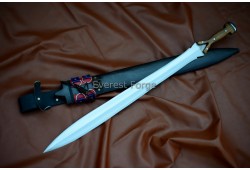

Bronze Age Swords – Hand-Forged Leaf Blade Replicas
Travel back over 3,000 years with our Bronze Age Swords collection — a tribute to some of the earliest functional weapons ever crafted. Long before iron dominated warfare, Bronze Age warriors from Mycenaean Greece, Mesopotamia, Egypt, and the Celtic world wielded leaf-shaped blades that combined utility and status. These swords were not only tools of war but symbols of power, skill, and societal rank.At Everest Forge, each blade is hand-forged in Nepal using traditional methods passed down through generations. While our swords are forged from high-carbon steel (5160 truck leaf spring) for modern strength and durability, they faithfully replicate the shapes, sizes, and aesthetics of ancient Bronze Age weapons.
The characteristic leaf-shaped blade—wide in the center and tapering at both ends—was ideal for powerful slashing, while some early straight blades allowed for both thrusting and cutting. Used by warriors of the Mycenaeans, Hittites, Celts, and Egyptians, these swords often featured simple organic handles made from wood, horn, or bone.
Whether you're a collector, reenactor, history lover, or martial artist, these blades are forged for real-world performance and historical authenticity.
What You'll Find in This Category:
-
Historically inspired leaf blade swords of the Late Bronze Age
-
Replicas based on Naue II swords, Celtic bronze swords, and Hittite blades
-
Fully functional blades, tempered and sharpened for actual use
-
Traditional full-tang construction for strength and balance
-
Scabbards made of wood and leather for safe storage
-
Custom engraving or hilt designs available upon request
Historical Context:
The Bronze Age (c. 3300–1200 BCE) marked the birth of metal weaponry. Bronze swords, cast and hammered into leaf-shaped forms, represented a leap forward in warfare, ritual, and craftsmanship. By 1500 BCE, these blades had spread across Europe, North Africa, and the Middle East. From the Naue Type II swords of the Mediterranean to Celtic leaf blades of Western Europe, each carried the cultural identity of the people who forged and wielded them. Some were discovered in tombs, buried with their owners as sacred items meant to accompany them into the afterlife.
Today, Bronze Age swords remain a powerful symbol of the dawn of martial technology, where craftsmanship met ceremony.


-250x170w.jpg)